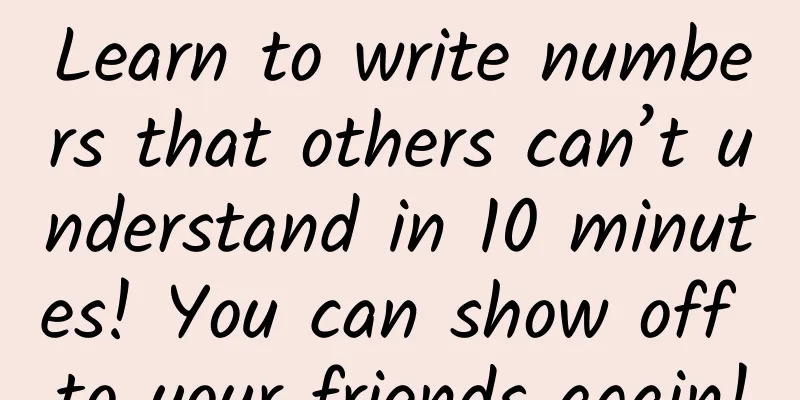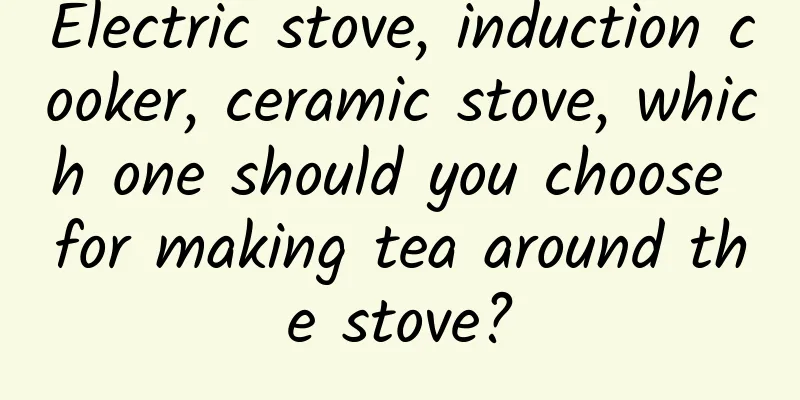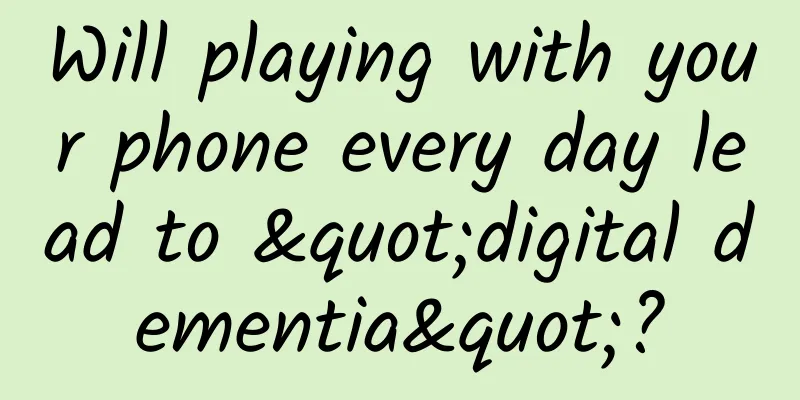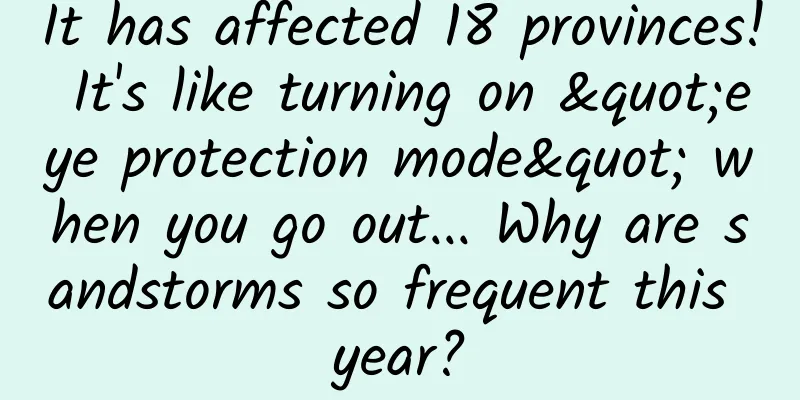Learn to write numbers that others can’t understand in 10 minutes! You can show off to your friends again!

|
In our daily life, we often use numbers. Arabic numerals were invented by Indians and spread to Europe through Arabs in the Middle Ages, gradually becoming the universal way of writing numbers. Arabic numerals are very convenient to write and conform to the numerical habits of most languages in the world. However, in history, there are definitely more ways to write numbers. Not only are the numbers different from Arabic numerals, but the decimal system is also different from the decimal system of Arabic numerals. Sometimes we don't want others to be able to easily understand the numbers we write, so it is necessary to master a "foreign language of numbers". For example, can you understand the following numbers? After reading this article, you will understand. 1. Cuneiform The ancient Babylonians lived in the area of today's Euphrates and Tigris rivers. The abundant water resources provided fertile land, giving birth to a highly developed early human civilization. The ancient Babylonians used reeds or wooden poles to press out characters on clay tablets. This type of writing looks like a triangular wedge, so it is called cuneiform. Around 2000 BC, the ancient Babylonians invented the method of using cuneiform to represent numbers. The cuneiform "1" is a vertical wedge, which is pressed on the clay tablet with the thin end of a reed; "10" is a horizontal, thicker wedge, which is pressed on the clay tablet with the thick end of a reed. Using these two symbols, "1" and "10", numbers from 1 to 59 can be easily expressed. So, how to represent 60? The ancient Babylonians used the sexagesimal system. When the number reached 60, 1 was added to the higher digit. If we use the decimal system of ones, tens, hundreds, and thousands, the ones digit of cuneiform represents a number of "1s", the tens digit represents a number of "60s", the hundreds digit represents a number of "60 squares (3600)", and the thousands digit represents a number of "60 cubes (216000)". For example, the following number represents the sum of 2 times 602, 30 times 60, and 11 times 1: The reason for this representation may be that 60 is a common multiple of many integers, such as 2, 3, 4, 5, 6, 10, 12, 15, 20, 30, and 60. Therefore, using the sexagesimal system, you can easily divide a number into 2, 3, 4, 5, 6, etc. Unfortunately, cuneiform originally did not have the number 0, so it is difficult to distinguish between "1" and "60" and "2" and "61". (If the number is a single digit, it means 2); (If this number is a two-digit number, it means 61) Now, have you learned cuneiform? 2. Kaktovik Numbers In northern Alaska, there is a small snowy city called Kaktovik. The entire city has a population of only more than 200 people, most of whom are Inuit who have lived in the Arctic Circle for generations. Their language habits are different from ours - they use the 5- and 20-base numerical representations. For example, the following table shows the reading of numbers within 20 in their language. You will find that they call 7 5+2, 8 5+3, and 16 15+1... This shows that they use the 5-base system. At the same time, they also read 27 as 20+5+2, 30 as 20+10, and 90 as 4 20 plus 10, which shows that their language still has a base 20 system. This is a language that is a mixture of base 5 and base 20. The decimal system used in Arabic numerals is not very friendly to them, and the math performance of Inuit students has always been not very good. In 1994, during a math activity class in a junior high school in this small town, several students suddenly thought: Why not invent a math representation method that suits their language habits? This method should combine the pentadecimal and twentieth bases, be beautiful, and easy to write and remember. So they designed a way to represent 1 with a vertical line and 5 with a horizontal line. When the vertical line reaches 5, it will increase by 1 (become a horizontal line), when the horizontal line reaches 4, it will increase by 1 (become a high vertical line), and when the whole number reaches 20, it will increase by 1. There is no 0 in the Inuit language, so they also invented a symbol similar to a person crossing his hands to represent 0. In this way, Kaktovik numbers were born. Kaktovik numbers are based on base 20, so the ones, tens, hundreds, etc. digits represent 1, 20, 202, etc., respectively. For example, the following number represents a number composed of 1 202, 11 20s, and 4 1s, which is 624 in total. It is very easy to calculate addition and subtraction using Kaktovik numbers. You just need to put all the corresponding vertical lines together, and then put all the corresponding horizontal lines together. Remember to add one when the vertical line reaches 5 (becomes a horizontal line), and add one when the horizontal line reaches 4 (becomes a high-position vertical line). (1+2=3 in Kaktovik numbers) The students also invented an abacus in which the beads on top represent 5 and the column on the bottom represents 1, which is similar to our Chinese abacus. It is said that the invention of this method of number representation has significantly improved the math scores of the entire city. Later, more and more official Inuit organizations began to adopt this method of number representation. It is really commendable that the numbers invented by junior high school students have become official numbers. 3. Monk Code In 13th century Europe, there was a branch of Catholicism called the Cistercians. They followed an ascetic practice method with strict rules, were lifelong vegetarians, lived in poverty, and were not allowed to speak, so they were also called the Dumb Order. Cistercian emblem In this church, there is a code-like number that can represent any integer between 1 and 9999 with one symbol. The monks use this method to count years. Let's learn it together! First, draw a vertical stick, and then draw different shapes on the upper right side of the stick to represent the 10 numbers 0-9. (The monk code consists of ten digits from 0 to 9) If you look closely, you will find that there is a relationship between these shapes: for example, 5 looks like a triangular flag, but it is actually composed of 4 (diagonal line) and 1 (horizontal line); similarly, 7 is composed of 6 and 1, 8 is composed of 6 and 2, and 9 is composed of 6, 1 and 2. If the number exceeds 10, you need to carry. The upper right, upper left, lower right, and lower left of this vertical stick represent the digits of the ones, tens, hundreds, and thousands respectively. As long as you write the corresponding numbers on each digit according to the digital plan, you can form a four-digit number. Note: When drawing symbols, you must draw them symmetrically from top to bottom and from left to right. Please compare the above examples and analyze why the following figures represent these numbers. Let’s analyze why these four numbers are written like this? Although each monk code can only represent a four-digit number, multiple code images can be combined to represent any number we want - just convert each 4-digit number into a monk code in groups of four. Because this method is decimal, which is consistent with the numbers we usually use, it is very convenient to convert. In this article, I have shown you how to represent cuneiform, Kaktovik numerals, and monk code numbers. Can you solve the problem at the beginning of this article? The picture below shows the same number in three different ways. What is this number? Show it off to your friends! (Note: If the second to last number is incorrect, please refer to the correct picture at the beginning of the article) END Source: Mr. Li Yongle |
<<: Anxiety is not what you think
>>: Today is the beginning of spring. Spring begins, and all seasons are peaceful.
Recommend
A popular blogger ate vegetarian food for 5 years and developed severe anemia. Why did this happen? Uncover the truth about vegetarianism
Is it healthier to be a vegetarian? In the eyes o...
CICC: China's new energy vehicle production and sales are expected to accelerate in the second half of the year, and cobalt and lithium battery material suppliers will benefit
CICC said that the Ministry of Industry and Infor...
In-depth analysis of the Douyin algorithm mechanism
There are thousands of ways to play Tik Tok . It ...
Japan has developed a physical mosquito repellent that can stop mosquitoes from flying within seconds with just one spray. How does this new technology work?
According to media reports, new research by Japan...
It is nonsense to say that the color TV industry is going to die out during the difficult transformation period
Recently, the news that some Japanese companies h...
Why do users keep churning? Teach you 3 stages of user retention methods
Product retention is similar to product onboardin...
“Street stall economy” brand leverages marketing and copywriting!
The way people greet each other these days has ch...
Baidu bidding OCPC delivery optimization guide!
What I want to talk about today is search OCPC. I...
Really lengthened. Spy photos of the domestically produced new Audi Q5 body in white
Earlier media reports said that the new FAW-Volks...
Pigeons can fire missiles, dead fish can swim? 2024 Ig Nobel Prize winners announced | Technology Weekly
Compiled by Zhou Shuyi and Wang Xiang Blood sugar...
How to manage an e-commerce operation activity?
For e-commerce platforms, it is no longer enough ...
How to plan an event? Four ways to plan an event!
Last week, a friend asked me why I didn’t share s...
Weibo Super Fans Practical Tutorial (30-hour video course)
Chapter 1: Introduction to Weibo Fantong Basics 1...
Android Advanced: Thorough Understanding of the Synchronized Keyword
[[417605]] This article is reprinted from the WeC...
ReactiveCocoa is so useful that I can’t stop using it
[[145435]] Foreplay I personally highly recommend...









![[Creative Cultivation Program] What efforts has mankind made to search for habitable planets outside the Earth?](/upload/images/67f262d0ba60e.webp)